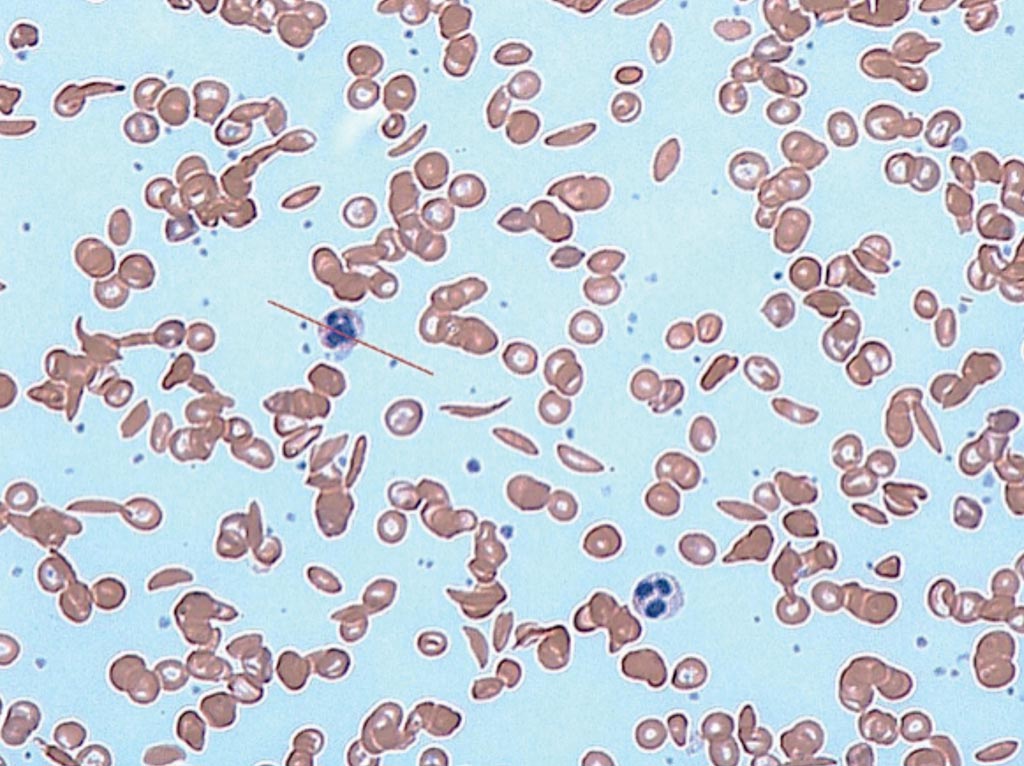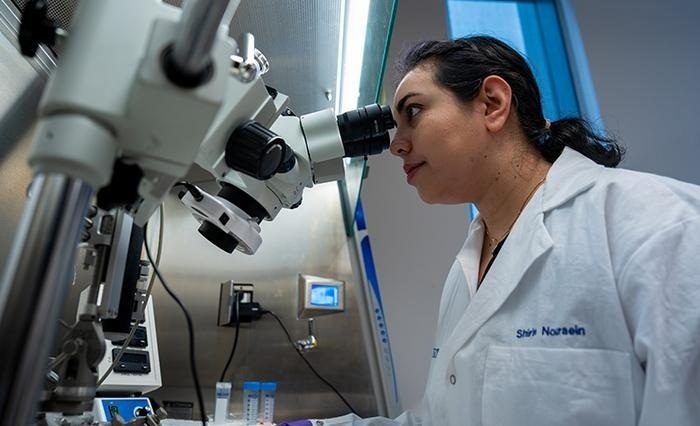Rapid Test for Sickle-Cell Disease Evaluated
|
By LabMedica International staff writers Posted on 15 Nov 2018 |

Image: A photomicrograph of sickle cells in human blood: both normal red blood cells and sickle-shaped cells are present (Photo courtesy of Dr. Graham Beards).
Sickle cell disease (SCD) is a common, life‐threatening genetic disorder that is best managed when diagnosed early by newborn screening. Sickle cell disease (SCD) is highly prevalent in sub-Saharan Africa and central India. Sickle cell anemia is the most common and severe form of SCD.
In sub-Saharan Africa, where up to 90% of children with SCD are thought to die undiagnosed before the age of five, screening tests in newborns have not been implemented universally. Early diagnosis and prevention can avert 70% of the deaths that occur in these regions due to SCD. However, the available diagnostic tests are costly, and cumbersome, and may take weeks or even months to inform the family of the diagnosis. Therefore, a point-of-care diagnostic tool for SCD is an urgent need.
An international team of hematologists collaborating with the Cincinnati Children's Hospital Medical Center (Cincinnati, OH, USA) included in their study 383 participants from Ghana, 46 from Martinique and 158 from the USA. The age range of the participants was newborn to 30 years; 16.6% of the participants from Ghana and Martinique were under one-month-old. Ghana also has a high prevalence HbS and HbC sub-types.
In this global, multi-center study, patient blood was tested using HemoType SC kits at the site of sample collection. The diagnostic accuracy of HemoTypeSC, a point‐of‐care immunoassay, for SCD was evaluated in individuals who had SCD, hemoglobin C disease, the related carrier (trait) states, or a normal hemoglobin phenotype. The accuracy of the result was compared with the evaluation done in a laboratory in order to validate the use of HemoType SC as a diagnostic tool to be used where sample collection is performed.
The authors reported that in 587 participants, across all study sites, HemoTypeSC had an overall sensitivity of 99.5% and specificity of 99.9% across all hemoglobin phenotypes. The test had 100% sensitivity and specificity for sickle cell anemia. Sensitivity and specificity for detection of normal and trait states were more than 99%. HemoTypeSC is an inexpensive at less than USD 2.00 per test, accurate, and rapid point‐of‐care test that can be used in resource‐limited regions with a high prevalence of SCD to provide timely diagnosis and support newborn screening programs.
The authors concluded that HemoTypeSC is an inexpensive, accurate, and rapid point-of-care test that can be used in resource-limited regions with a high prevalence of sickle cell disease to provide timely diagnosis and support newborn screening programs. The study was first published on October 5, 2018, in the American Journal of Hematology.
Related Links:
Cincinnati Children's Hospital Medical Center
In sub-Saharan Africa, where up to 90% of children with SCD are thought to die undiagnosed before the age of five, screening tests in newborns have not been implemented universally. Early diagnosis and prevention can avert 70% of the deaths that occur in these regions due to SCD. However, the available diagnostic tests are costly, and cumbersome, and may take weeks or even months to inform the family of the diagnosis. Therefore, a point-of-care diagnostic tool for SCD is an urgent need.
An international team of hematologists collaborating with the Cincinnati Children's Hospital Medical Center (Cincinnati, OH, USA) included in their study 383 participants from Ghana, 46 from Martinique and 158 from the USA. The age range of the participants was newborn to 30 years; 16.6% of the participants from Ghana and Martinique were under one-month-old. Ghana also has a high prevalence HbS and HbC sub-types.
In this global, multi-center study, patient blood was tested using HemoType SC kits at the site of sample collection. The diagnostic accuracy of HemoTypeSC, a point‐of‐care immunoassay, for SCD was evaluated in individuals who had SCD, hemoglobin C disease, the related carrier (trait) states, or a normal hemoglobin phenotype. The accuracy of the result was compared with the evaluation done in a laboratory in order to validate the use of HemoType SC as a diagnostic tool to be used where sample collection is performed.
The authors reported that in 587 participants, across all study sites, HemoTypeSC had an overall sensitivity of 99.5% and specificity of 99.9% across all hemoglobin phenotypes. The test had 100% sensitivity and specificity for sickle cell anemia. Sensitivity and specificity for detection of normal and trait states were more than 99%. HemoTypeSC is an inexpensive at less than USD 2.00 per test, accurate, and rapid point‐of‐care test that can be used in resource‐limited regions with a high prevalence of SCD to provide timely diagnosis and support newborn screening programs.
The authors concluded that HemoTypeSC is an inexpensive, accurate, and rapid point-of-care test that can be used in resource-limited regions with a high prevalence of sickle cell disease to provide timely diagnosis and support newborn screening programs. The study was first published on October 5, 2018, in the American Journal of Hematology.
Related Links:
Cincinnati Children's Hospital Medical Center
Latest Hematology News
- Platelet Activity Blood Test in Middle Age Could Identify Early Alzheimer’s Risk
- Microvesicles Measurement Could Detect Vascular Injury in Sickle Cell Disease Patients
- ADLM’s New Coagulation Testing Guidance to Improve Care for Patients on Blood Thinners
- Viscoelastic Testing Could Improve Treatment of Maternal Hemorrhage
- Pioneering Model Measures Radiation Exposure in Blood for Precise Cancer Treatments
- Platelets Could Improve Early and Minimally Invasive Detection of Cancer
- Portable and Disposable Device Obtains Platelet-Rich Plasma Without Complex Equipment
- Disposable Cartridge-Based Test Delivers Rapid and Accurate CBC Results
- First Point-of-Care Heparin Monitoring Test Provides Results in Under 15 Minutes

- New Scoring System Predicts Risk of Developing Cancer from Common Blood Disorder
- Non-Invasive Prenatal Test for Fetal RhD Status Demonstrates 100% Accuracy
- WBC Count Could Predict Severity of COVID-19 Symptoms
- New Platelet Counting Technology to Help Labs Prevent Diagnosis Errors
- Streamlined Approach to Testing for Heparin-Induced Thrombocytopenia Improves Diagnostic Accuracy
- POC Hemostasis System Could Help Prevent Maternal Deaths
- New Test Assesses Oxygen Delivering Ability of Red Blood Cells by Measuring Their Shape
Channels
Clinical Chemistry
view channel
Chemical Imaging Probe Could Track and Treat Prostate Cancer
Prostate cancer remains a leading cause of illness and death among men, with many patients eventually developing resistance to standard hormone-blocking therapies. These drugs often lose effectiveness... Read more
Mismatch Between Two Common Kidney Function Tests Indicates Serious Health Problems
Creatinine has long been the standard for measuring kidney filtration, while cystatin C — a protein produced by all human cells — has been recommended as a complementary marker because it is influenced... Read moreMolecular Diagnostics
view channel
Genetic Marker to Help Children with T-Cell Leukemia Avoid Unnecessary Chemotherapy
About 400 children in the UK are diagnosed with acute lymphoblastic leukemia (ALL) each year, with roughly 15% presenting with a more aggressive T-ALL subtype. While the standard approach is a four-week... Read more
Four-Gene Blood Test Rules Out Bacterial Lung Infection
Lower respiratory tract infections (LRTIs) are among the most common reasons for antibiotic prescriptions, yet distinguishing bacterial infections from viral ones remains notoriously difficult.... Read more
New PCR Test Improves Diagnostic Accuracy of Bacterial Vaginosis and Candida Vaginitis
Bacterial vaginosis (BV) impacts approximately 25% of women of reproductive age, while up to 75% of women experience candida vaginitis (CV) at least once in their lifetime. Vaginal symptoms are one of... Read moreImmunology
view channel
New Test Distinguishes Vaccine-Induced False Positives from Active HIV Infection
Since HIV was identified in 1983, more than 91 million people have contracted the virus, and over 44 million have died from related causes. Today, nearly 40 million individuals worldwide live with HIV-1,... Read more
Gene Signature Test Predicts Response to Key Breast Cancer Treatment
DK4/6 inhibitors paired with hormone therapy have become a cornerstone treatment for advanced HR+/HER2– breast cancer, slowing tumor growth by blocking key proteins that drive cell division.... Read more
Chip Captures Cancer Cells from Blood to Help Select Right Breast Cancer Treatment
Ductal carcinoma in situ (DCIS) accounts for about a quarter of all breast cancer cases and generally carries a good prognosis. This non-invasive form of the disease may or may not become life-threatening.... Read moreMicrobiology
view channel
Rapid Diagnostic Test Matches Gold Standard for Sepsis Detection
Sepsis kills 11 million people worldwide every year and generates massive healthcare costs. In the USA and Europe alone, sepsis accounts for USD 100 billion in annual hospitalization expenses.... Read moreRapid POC Tuberculosis Test Provides Results Within 15 Minutes
Tuberculosis remains one of the world’s deadliest infectious diseases, and reducing new cases depends on identifying individuals with latent infection before it progresses. Current diagnostic tools often... Read more
Rapid Assay Identifies Bloodstream Infection Pathogens Directly from Patient Samples
Bloodstream infections in sepsis progress quickly and demand rapid, precise diagnosis. Current blood-culture methods often take one to five days to identify the pathogen, leaving clinicians to treat blindly... Read morePathology
view channelAI Tool Outperforms Doctors in Spotting Blood Cell Abnormalities
Diagnosing blood disorders depends on recognizing subtle abnormalities in cell size, shape, and structure, yet this process is slow, subjective, and requires years of expert training. Even specialists... Read more
AI Tool Rapidly Analyzes Complex Cancer Images for Personalized Treatment
Complex digital biopsy images that typically take an expert pathologist up to 20 minutes to assess can now be analyzed in about one minute using a new artificial intelligence (AI) tool. The technology... Read moreTechnology
view channel
Artificial Intelligence Model Could Accelerate Rare Disease Diagnosis
Identifying which genetic variants actually cause disease remains one of the biggest challenges in genomic medicine. Each person carries tens of thousands of DNA changes, yet only a few meaningfully alter... Read more
AI Saliva Sensor Enables Early Detection of Head and Neck Cancer
Early detection of head and neck cancer remains difficult because the disease produces few or no symptoms in its earliest stages, and lesions often lie deep within the head or neck, where biopsy or endoscopy... Read moreIndustry
view channel
Abbott Acquires Cancer-Screening Company Exact Sciences
Abbott (Abbott Park, IL, USA) has entered into a definitive agreement to acquire Exact Sciences (Madison, WI, USA), enabling it to enter and lead in fast-growing cancer diagnostics segments.... Read more






















